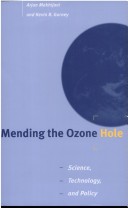The MIT Press
1 total work
There is a widely held misconception that the problem of ozone depletion in the upper atmosphere has been solved. In fact, while CFC production has been reduced in many places, the ongoing emissions of chemicals and the production of other long-lived ozone-depleting substances mean a decade will pass before the levels of ozone-depleting chlorine in the earth's atmosphere being to decline. As a result, serious ozone depletion above the southern pole and elsewhere is expected to continue for decades, posing a severe threat to human health and to ecosystems.In this comprehensive overview, Makhijani and Gurney detail the most current knowledge about stratospheric ozone depletion. More than a review of the evolution of the ozone problem, Mending the Ozone Hole provides an objective and stimulating look at current debates surrounding the research, the technology development, and the policy-making aimed at eliminating ozone-depleting substances.The book begins by clearly delineating the current status of stratospheric ozone loss and its epidemiological and ecological consequences -- including DNA damage, effects on the human immune system, skin cancer, the human eye, plant and aquatic life, and potential impacts of persistent severe ozone depletion.
It then takes up the many sources of emissions of ozone-depleting compounds and of the alternative technologies that might reasonably replace them. This is followed by an examination of national and international policy development and industry responses, projections on the levels of ozone-depleting chlorine, assessments of various ozone-protection measures, and a consideration of the context in which policy is made. Finally, the research findings are summarized and specific recommendations for protecting the ozone layer are offered
It then takes up the many sources of emissions of ozone-depleting compounds and of the alternative technologies that might reasonably replace them. This is followed by an examination of national and international policy development and industry responses, projections on the levels of ozone-depleting chlorine, assessments of various ozone-protection measures, and a consideration of the context in which policy is made. Finally, the research findings are summarized and specific recommendations for protecting the ozone layer are offered
